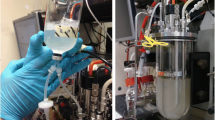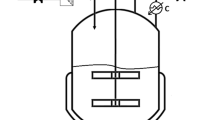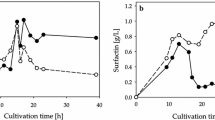Abstract
Biosurfactants increasingly gain attention due to the manifold of possible applications and production on the basis of renewable resources. Owing to its various characteristics, Surfactin is one of the most studied biosurfactants. Since its discovery, several Surfactin producers have been identified, but their capacity to produce Surfactin has not been evaluated in a comparison. Six different Bacillus strains were analyzed regarding their ability to produce Surfactin in model fermentations with integrated foam fractionation, for in situ product enrichment and removal. Three of the investigated strains are commonly used in Surfactin production (ATCC 21332, DSM 3256, DSM 3258), whereas two Bacillus strains are described for the first time (DSM 1090, LM43a50°C) as Surfactin producers. Additionally, the Bacillus subtilis type strain DSM 10T was included in the evaluation. Interestingly, all strains, except DSM 3256, featured high values for Surfactin recovered from foam in comparison to other studies, ranging between 0.4 and 1.05 g. The fermentation process was characterized by calculating procedural parameters like substrate yield Y X/S, product yield Y P/X, specific growth rate μ, specific productivity q Surfactin, volumetric productivity q Surfactin, Surfactin and bacterial enrichment as well as Surfactin recovery. The strains differ most in specific and volumetric productivity; nevertheless, it is evident that it is not possible to name a Bacillus strain that is the most appropriate for the production of Surfactin under these conditions. In contrast, it becomes apparent that the choice of a specific strain should depend on the applied fermentation conditions.



Similar content being viewed by others
References
Arima K, Kakinuma A, Tamura G (1968) Surfactin, a crystalline peptide lipid surfactant produced by Bacillus subtilis: isolation, characterization and its inhibition of fibrin clot formation. Biochem Biophys Res Commun 31:488–494
Banat IM, Franzetti A, Gandolfi I, Bestetti G, Martinotti MG, Fracchia L, Smyth TJ, Marchant R (2010) Microbial biosurfactants production, applications and future potential. Appl Microbiol Biotechnol 87:427–444
Baumgart F, Kluge B, Ullrich C, Vater J, Ziessow D (1991) Identification of amino acid substitutions in the lipopeptide Surfactin using 2D NMR spectroscopy. Biochem Biophys Res Commun 177:998–1005
Bertani G (1951) Studies on lysogenesis. I: the mode of phage liberation by lysogenic Escherichia coli 1. J Bacteriol 62:293
Buchoux S, Lai-Kee-Him J, Garnier M, Tsan P, Besson F, Brisson A, Dufourc EJ (2008) Surfactin-triggered small vesicle formation of negatively charged membranes: a novel membrane-lysis mechanism. Biophys J 95:3840–3849
Chen CY, Baker SC, Darton RC (2006) Batch production of biosurfactant with foam fractionation. J Chem Technol Biotechnol 81:1923–1931
Cooper D, Macdonald C, Duff S, Kosaric N (1981) Enhanced production of Surfactin from Bacillus subtilis by continuous product removal and metal cation additions. Appl Environ Microbiol 42:408–412
Davis D, Lynch H, Varley J (2001) The application of foaming for the recovery of Surfactin from B. subtilis ATCC 21332 cultures. Enzym Microb Technol 28:346–354
Falardeau J, Wise C, Novitsky L, Avis TJ (2013) Ecological and mechanistic insights into the direct and indirect antimicrobial properties of Bacillus subtilis lipopeptides on plant pathogens. J Chem Ecol 39:869–878
Freitas de Oliveira DW, Lima Franca ÍW, Nogueira Félix AK, Lima Martins JJ, Aparecida Giro ME, Melo VMM, Goncalves LRB (2013) Kinetic study of biosurfactant production by Bacillus subtilis LAMI005 grown in clarified cashew apple juice. Colloids Surf, B 101:34–43
Isa MHM, Coraglia DE, Frazier RA, Jauregi P (2007) Recovery and purification of Surfactin from fermentation broth by a two-step ultrafiltration process. J Membr Sci 296:51–57
Kowall M, Vater J, Kluge B, Stein T, Franke P, Ziessow D (1998) Separation and characterization of Surfactin isoforms produced by Bacillus subtilis OKB 105. J Colloid Interface Sci 204:1–8
Liu JF, Yang J, Yang SZ, Ye RQ, Mu BZ (2012) Effects of different amino acids in culture media on Surfactin variants produced by Bacillus subtilis TD7. Appl Biochem Biotechnol 166:2091–2100
Nitschke M, Pastore GM (2004) Biosurfactant production by Bacillus subtilis using cassava-processing effluent. Appl Biochem Biotechnol 112:163–172
Ohno A, Ano T, Shoda M (1995) Production of a lipopeptide antibiotic, Surfactin, by recombinant Bacillus subtilis in solid state fermentation. Biotechnol Bioeng 47:209–214
Parthasarathy S, Das TR, Kumar R, Gopalakrishnan KS (1988) Foam separation of microbial cells. Biotechnol Bioeng 32:174–83
Peypoux F, Michel G (1992) Controlled biosynthesis of Val7- and Leu7-Surfactins. Appl Microbiol Biotechnol 36:515–517
Peypoux F, Bonmatin J, Wallach J (1999) Recent trends in the biochemistry of Surfactin. Appl Microbiol Biotechnol 51:553–563
Schallmey M, Singh A, Ward OP (2004) Developments in the use of Bacillus species for industrial production. Can J Microbiol 50:1–17
Sheppard JD, Mulligan CN (1987) The production of Surfactin by Bacillus subtilis grown on peat hydrolysate. Appl Microbiol Biotechnol 27:110–116
Tsukagoshi N, Tamura G, Arima K (1970) A novel protoplast-bursting factor (Surfactin) obtained from Bacillus subtilis IAM 1213: II. The interaction of Surfactin with bacterial membranes and lipids. Biochim Biophys Acta 196:211–214
Vollenbroich D, Özel M, Vater J, Kamp RM, Pauli G (1997) Mechanism of inactivation of enveloped viruses by the biosurfactant Surfactin from Bacillus subtilis. Biologicals 25:289–297
Yoneda T (2001) Surfactin sodium salt: an excellent bio-surfactant for cosmetics. J Cosmet Sci 52:153–154
Acknowledgments
The authors would like to thank Dr. Ralph Lovis for his research contribution. During his work at the Institute of Process Engineering in Life Sciences at the Karlsruhe Institute of Technology (KIT), he isolated the Bacillus strain LM43a50°C, which was later rediscovered and used in the current study.
Author information
Authors and Affiliations
Corresponding author
Electronic supplementary material
Below is the link to the electronic supplementary material.
ESM 1
(PDF 280 kb)
Rights and permissions
About this article
Cite this article
Willenbacher, J., Zwick, M., Mohr, T. et al. Evaluation of different Bacillus strains in respect of their ability to produce Surfactin in a model fermentation process with integrated foam fractionation. Appl Microbiol Biotechnol 98, 9623–9632 (2014). https://doi.org/10.1007/s00253-014-6010-2
Received:
Revised:
Accepted:
Published:
Issue Date:
DOI: https://doi.org/10.1007/s00253-014-6010-2




